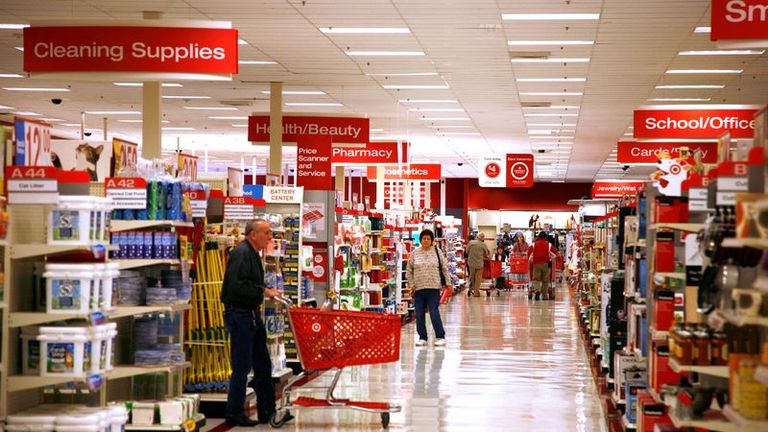NEW YORK, April 2 (Reuters) - While streaming a favorite TV show as her baby naps, an ad for Enfamil NeuroPro infant formula pops on a new mother's screen.
She whips out her phone to scan the ad's "quick response" code. It directs her phone to Target's website to complete the $46.49 purchase.
Sales of merchandise at Target stores have fallen for three consecutive quarters as Americans seek bargains at rivals Walmart and direct-to-consumer retailers PDD Group's Temu and Shein.
Minneapolis-based Target projects its comparable sales will be ho-hum - flat to up 2% - this year.
But Target's retail media unit, a business through which it creates and sells ads, grew more than 20% in its fiscal year ended Feb. 3, Target CEO Brian Cornell said during Target's March 5 analyst day in New York.
Overall, product makers and other advertisers are expected to spend $60 billion total to advertise on U.S. retailers' media networks in 2024, according to estimates from Emarketer, a market research company. From Walmart to Amazon, and from Macy's to Home Depot, more retailers are betting on revenue from advertising.
Target's ad business, which it calls Roundel, generated $1.5 billion in "value," Target's CEO Cornell said, adding that its ad business benefited Target's gross margins more than its revenue.
With tech companies like Google tightening their grip on third-party data sharing with advertisers, advertisers are eager to glean insights from retailers like Target, according to representatives from four advertising agencies specializing in consumer goods. Shoppers make more than 250 million visits a year to Target stores and its website.
Enfamil and Apple are both among what Cara Sylvester, chief guest experience officer at Target, said was a pool of 2,600 brands that pay Target to craft product advertisements that reach certain Target shoppers, including on social media and streaming platforms.
Last year, for instance, Apple partnered with Roundel on a holiday campaign for its Apple Watch Series 9, Sylvester said, adding that the campaign attracted a significantly higher number of new shoppers, many from outside of Target's app and website, than Apple's prior campaigns with Target. Apple confirmed it worked with Target on the ad but declined further comment.
And when Enfamil maker Reckitt wanted to reach young parents, Target tapped into its own shopper data to identify an audience of likely buyers. It zeroed in on Target shoppers who either bought baby gear over the previous six months, or NeuroPro formula over the previous year. It then tapped its ongoing partnerships with smart-TV device makers such as Roku Streaming Stick and Fire TV stick to display the ad - with a scan-to-buy QR code - to the target buyer group.
Nich Weinheimer, executive vice president of strategy at Skai, a marketing agency whose clients include Philips, Kellogg, and Sony, said advertisers see Target as a prime vehicle for reaching new moms and heads of households who buy household products and clothing and accessories.
According to Numerator, a research firm that tracks shopper behavior, Target's shoppers are primarily white and female, live in suburban or urban areas, and have a household income between $40,000 and $125,000.
Target doesn't hand over its individual shopper data to its advertising clients, but rather shares aggregated shopper data without personally identifiable information, a Target spokesperson said.
Target investor Huntington Private Bank likes Target's profitable ad business, and hopes Target will use the proceeds from advertising sales to lower its prices on the merchandise it sells online and in stores.
"Getting more and more into the ad opportunity ... is where the real money is," said David Klink, a senior equity analyst at Huntington Private Bank, which holds more than $20 million in Target shares.
Enfamil said it spent what it said was a six-figure sum for the advertisement that ran from mid June though the end of July. Target managed the entire campaign, according to a Target case study summarizing the campaign's results. In its summary of the Enfamil campaign, Target said 15.8 million shoppers viewed the ad. Target's strategy of marketing the formula to past baby product purchasers delivered a roughly 31% better return on Enfamil's ad spending than if Target had directed the ad only to past NeuroPro purchasers, according to the case study.
Enfamil said it would continue to work with Roundel on more ads in the future. But three advertisers told Reuters that Roundel offers them less control to manage their own ad campaigns compared to rivals such as Amazon and Walmart, both of which operate much bigger retail media units.
"(Target's media network) Roundel is an important business at Target and we see our curated approach as a key point of difference in helping Roundel drive value," said Sarah Travis, president of Roundel, in a statement to Reuters.
Target launched a new feature in its ad business this year, which gives marketers more control over their campaigns and better access to some of its shopper data and marketplace sellers when the advertisers purchase search ads, she said. So-called sponsored product ads pop up when shoppers search online using key words like "best coffee" or "men's bodywash."
(Reporting by Siddharth Cavale in New York Editing by Nick Zieminski)




